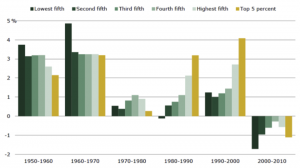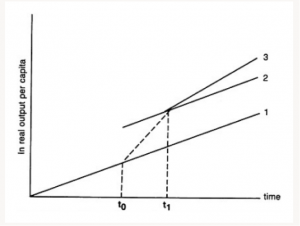USA Economic Development History
The US economy is sometimes characterized as a “capitalist” market, a phrase coined by 19th-century German philosopher and political economist Karl Marx to describe a structure where a small group makes the most basic economic decisions of individuals who own significant amounts of capital or resources. Marx associated the capitalistic systems with those of “socialism,” which exercised more influence throughout the political process. Marx and his supporters claimed that free-market economies focus exclusively on the resources of influential business individuals, mainly aimed at maximizing profits. On either hand, socialist systems are more inclined to have increased government influence, which appears to set political objectives.
More equitable allocation of the assets in the society, for example— before profits, Whereas those definitions have elements of truth about them, albeit overstated, they are much less applicable today. If Marx’s free-market capitalism still prevailed, the capitalist economic system has long been forgotten. As policymakers throughout the United States and several other nations have participated in their markets to restrict concentrations of wealth and tackle several of the societal issues correlated with unregulated private business concerns. As a response, the American economic system is accurately illustrated as a “mixed” system, with the state playing a significant role alongside private companies (Magnuson, 2011).
The economic components are workforce and raw materials, which turn available resources into commodities. The number of employees eligible, and, more significantly, their performance, helps to decide domestic economy wellbeing. The United States has seen consistent growth in its labor force across its existence, and that, in effect, has helped drive near-constant economic advancement. Most of the employees included refugees from European Nations, their direct relatives, or black-Americans whose predecessors were introduced as captives to America. Significant numbers of Asians moved to the USA to the United States during the initial years of the 20th generation, while several Latin American settlers came in subsequent years (Daly & Regev, 2020).

The graph indicates labor participation in the USA. Comparatively, higher labor participation in a country leads to higher economic growth in the Nation. Since the USA had a high labor force employed in the companies, the company had the potential of picking and developing.
Even though the USA endured several periods of intense poverty, as well as other periods when there was a shortage of labor, foreigners generally came when there was plenty of work. While eager to work for slightly lower salaries than assimilated employees, they usually thrived, receiving much more within their ancestral lands than they might have made. The country also flourished, so the economy improved rapidly sufficiently consumes even more new arrivals. The value of the labor accessible— how difficult persons are willing and able to operate and how qualified they are— is at least as practical to the economic prosperity of a nation as the level of the labor force (Magnuson, 2011).
And then that characteristic was strengthened by what is considered as the Labour theory of value. Also contributing to USA economic achievement was a substantial investment in education such as practical and tertiary education, which led to readiness to collaborate and adjust. Additionally, allocative efficiency has been essential to the United States economy’s ability to cope with changing circumstances. As migrant workers overwhelmed East Coast global markets, several jobs migrated inland, often to agricultural land getting ready to get tilled. Analogously, during the first half of the 20th generation, employment opportunities in manufacturing, northern towns enticed black-Americans from South ranches.
Some businesses continue to function with such a traditional narrative, but many have embarked on growing managerial opinions. American companies are pursuing more flexible organizational structures, particularly in big-tech industries that hire skilled personnel and need to develop, revise, and even personalize brands quickly. It is progressively assumed that increased hierarchical structure and competition of labor inhibit creative thinking. Businesses have “flattened” their systems of governance, decreased the number of supervisors, and delegated more power to integrative employees ‘ groups.
The United States does indeed have a free market economy since private, and state-owned companies play significant functions. Indeed, several American economic literature’s enduring discussions center on the comparative responsibilities of the business and government. The United States capitalist system places particular emphasis on private ownership. Private enterprises manufacture most services and products, and approximately two-thirds of the overall economic productivity of the country fall under individuals for private use (the remaining one-third is purchased by state and business). Indeed the role of the end user is so significant that somehow the country is very often described as a consumer economy (Magnuson, 2011).
The value of the products and services is determined by supply and demand. Prices, in effect, indicate to the companies what to manufacture; if consumers need more of a given product than the market generates, the value of the commodity will increase. The increase in demand gets the attention of emerging or predominant businesses that start producing more of a product, recognizing a chance of earning income. If consumers need less of the nice, prices will fall, and less efficient manufacturers will be forced out of the market or start generating alternative products. Participants can help steer the economic system not only through the decisions they render as customers but also through the ballots they place for economic policy-making authorities (Rein, 2017).
The state is solely charged with the responsibility of the application of the law, schooling, the transportation system, social statistics monitoring, and national defense. The development of infrastructure and security are vital to the development of critical sectors in the economy. A sound infrastructure system leads to the smooth movement of goods and services. It also aids the movement of persons, which leads to economic development. The United States has long developed its infrastructure, which has led to rapid growth in the economic system.
Additionally, the administration is often called upon to take action in the economic system to address conditions where the price mechanism is not working. For instance, it controls “essential services” and uses consumer protection laws to restrict or break up individual corporate partnerships, which become so dominant they can overpower market mechanisms. The Policy also addresses issues outside the free market’s control.
Rapid expansion in America during the early post-war duration benefited the middle and working classes. Indeed the lowest fifth of all families did better. Then, throughout the 1970s, situations came to a standstill amid two fuel shocks and terrible rising real interest rates. The Nation endorsed the center-left general agreement of the post-war duration and instead attempted Reaganism. W the administration adopted to cut taxes and increase government spending to stimulate the economy. Overseas innovation and globalization began to whittle away office jobs. The stock markets began to take off. And therefore, once growth resumed, it supported the investor class— the upper 20%, and correctly the top 5% (Weissmann, 2020).
Average annual change in the family income from 1950 to 2010,

 source: (Daly & Regev, 2020).
source: (Daly & Regev, 2020).
Alternative policies to growth, technical transition, and capital accumulation. T0, Investment strategy leads to increased wealth creation and a shift to higher incomes. T1, the economy recovers long-term expansion rates, or transitions to faster growth trajectory through expenditure engagement and technological transformation.
References
Daly, M., & Regev, T. (2020). Federal Reserve Bank of San Francisco | Labor Force Participation and the Prospects for US Growth. Retrieved 30 January 2020, from https://www.frbsf.org/economic-research/publications/economic-letter/2007/november/labor-force-participation-us-growth/
Magnuson, J. (2011). Mindful economics: how the US economy works, why it matters, and how it could be different. Seven Stories Press.
Rein, M. (2017). From Policy to Practice. Routledge.
Weissmann, J. (2020). 60 Years of American Economic History, Told in 1 Graph. Retrieved 30 January 2020, from https://www.theatlantic.com/business/archive/2012/08/60-years-of-american-economic-history-told-in-1-graph/261503/


